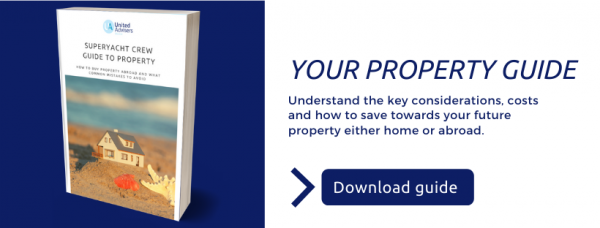15th Apr 2021
Portfolio Investment vs. Buying a Property: Which Is Better?
When deciding whether to invest in property or a portfolio investment, there is not a simple answer. Both offer advantages and come with risks, so finding the better option depends on numerous factors including your financial means, personality, and comfort with risk.
If you are new to investing and trying to pick between the two, it is important to know the benefits and drawbacks of each strategy.
Buying a Property

Property can be a wonderful investment for yacht crew. It can provide a real sense of stability whilst offering a passive revenue stream if you choose to rent it out whilst you are onboard.
We are not here to tell you if a property purchase is right for you. Our goal is to share the key considerations, and occasional pitfalls, which come with investing in bricks and mortar.
Benefits
Generally, with rising inflation, we see a rise in house prices and sometimes a higher margin of profit to be made when it comes to investing in property over the years.
This allows for a stable income, that increases as time goes on. You are reaping the rewards year after and year and are seeing a higher return without having to think too much about it.
Moreover, when you invest in property, you open yourself up to numerous tax benefits. Many of your outgoing costs can be deducted as business expenses.
Aside from the obvious point here, having a property can be of great value in many ways. The joys that come from tending to the property and the hard work that goes into reconstruction or the management of tenants is a rewarding way for that cash flow to come in.
Besides, what beats home comforts and knowing you have a place you can always go to.
Drawbacks
It seems as though property is a great way to go but as with everything, we need to consider the downsides that come with such an investment.
Owning and running a property comes at a cost and not just a monetary one, when it comes to maintaining and managing a physical asset such as a home, a lot of work must be put into it.
From renovations to repairs, acquiring and overseeing tenants to navigating house laws and homeowner associations – it may well become a full-time job.
With a property, as much as we would like to think a down payment means a steady flow of income that increases with time, that is not entirely the case.
Property will constantly require a stream of income into it, whether that’s general work that needs to be done or the various fees that are encountered with mortgage changes, associations and so forth.
If the property sits empty for some time also, you end up losing money rather than making it.
The acquiring of property, though straightforward for most, requires a large sum of money, to begin with, and involves quite a bit of work to sell and receive that large chunk of change at the end of it.
You will need to go through various hoops when purchasing the property and are in for the long game to sell.
Portfolio Investment


For those that are looking to broaden their horizons with Portfolio Investment, or simply think property Investment is not the right step at this time, we have listed a few reasons why it could be a great option for anyone looking to accumulate a diversified income.
Benefits
Perhaps the best part of portfolio investment is the level of returns you can gain for the very little amount of effort on your part, additionally, research has indicated that Portfolio Investment has the greatest potential to increase profits with each coming year.
The longer you hold onto these investments the more chance of increasing your cash flow. Reinvestment is also a great way to continue this cycle and build your wealth long term.
With this kind of investment, it is much easier to release your assets when needed. While hasty decisions may not work in your favour, if you need to sell you can do so without encountering any lengthy processes.
Drawbacks
As we determined above, Portfolio Investment certainly has its strengths, but they do not come without its shortfalls.
If you do not have the knowledge behind you or have not done enough research, it is often at times difficult to decipher companies’ true figures and to gauge if this investment will be a lucrative decision in the long run.
One blunder from a company’s deciding board could have substantial consequences. Therefore, seeking professional help from a regulated, qualified financial advisor, can always allow you to minimise these risks.
You will need to be patient with a Portfolio and the varying nature of this type of investment may at times be off-putting. You will need to play the long game but also be aware of the warning signs.
Though being able to track this readily offers a solution to the uncertainty that comes with an investment of this kind.
It appears both have their pros and cons, however, the time spent maintaining the property and dealing with all associated problems may outweigh the cost of investing in it.
With an Investment Portfolio, you can sit back and have the cash flow coming in with minimal time and effort on your end.
Work with an investment professional
The first step to investing is to have a financial plan. You need an accurate picture of your overall financial situation, including how much you have available to invest and for how long, as well as your tolerance for risk. Working with an adviser can help you achieve this.
If you are keen to better understand your financial situation, please contact our team of experienced financial advisers, here.
Alternatively, if you are considering purchasing property and want more information about the pros and cons versus other investment opportunities, we recommend downloading our crew property guide:




